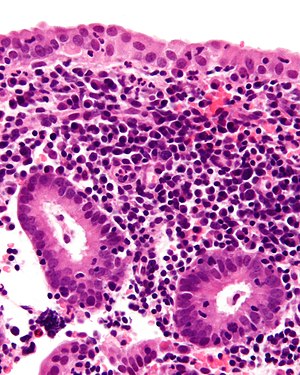Endometritis
| Endometritis | |
|---|---|
 |
|
| Micrograph showing a chronic endometritis with the characteristic plasma cells. Scattered neutrophils are also present. H&E stain. | |
| Classification and external resources | |
| Specialty | gynaecology |
| ICD-10 | N71 |
| ICD-9-CM | 615.9 |
| DiseasesDB | 4283 |
| MedlinePlus | 001484 |
| eMedicine | med/676 ped/678 |
| MeSH | D004716 |
Endometritis is inflammation of the endometrium, the inner lining of the uterus.
Pathologists have traditionally classified endometritis as either acute or chronic: acute endometritis is characterized by the presence of microabscesses or neutrophils within the endometrial glands, while chronic endometritis is distinguished by variable numbers of plasma cells within the endometrial stroma. The most common cause of endometritis is infection. Symptoms include lower abdominal pain, fever and abnormal vaginal bleeding or discharge. Caesarean section, prolonged rupture of membranes and long labor with multiple vaginal examinations are important risk factors. Treatment is usually with broad-spectrum antibiotics.
The term "endomyometritis" is sometimes used to specify inflammation of the endometrium and the myometrium.
Acute Endometritis is characterized by infection. The organisms most often isolated are believed to be because of compromised abortions, delivery, medical instrumentation, and retention of placental fragments. There is not enough evidence for the use of prophylactic antibiotics to prevent endometritis after manual removal of placental in vaginal birth. Histologically, neutrophilic infiltration of the endometrial tissue is present during acute endometritis. The clinical presentation is typically high fever and purulent vaginal discharge. Menstruation after acute endometritis is excessive and in uncomplicated cases can resolve after 2 weeks of clindamycin and gentamicin IV antibiotic treatment.
...
Wikipedia
